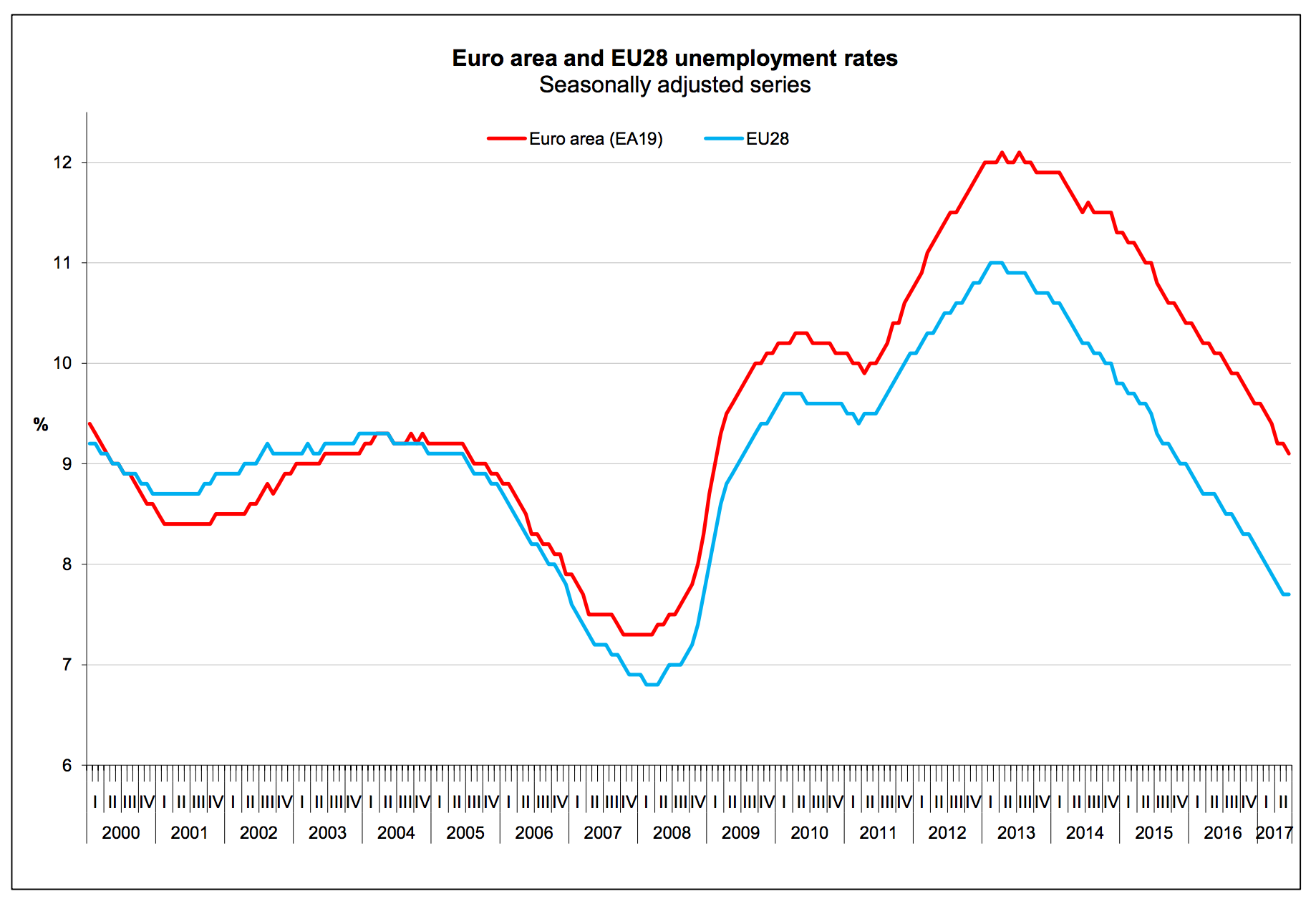Unemployment in the Eurozone has fallen to its lowest level since 2009

Youth unemployment is falling in Europe, but the numbers remain worrying Image: REUTERS/Thomas Peter
Unemployment in the Eurozone has now fallen to its lowest level since early 2009, as the single-currency area continues along a road of economic recovery one year after the Brexit vote rattled confidence in the bloc's future.
In June this year, euro-area unemployment dropped to 9.1%, down from 9.2% the previous month, and from 10.1% in the same month in 2016. This pattern reflects a trend seen across the EU as a whole, where the jobless rate in June was 7.7%, down from 8.6% a year earlier, according to the latest Eurostat data.
“The encouraging news on job growth in Europe reflects the broader positive momentum we are seeing. In addition to the stronger economic data, the overall trust of citizens in the EU is on the rise as people feel more optimistic about the future,” said Martina Larkin, head of Europe at the World Economic Forum.
The latest Eurobarometer survey found that a majority of Europeans - or 56% - were optimistic about the future of the EU, an increase of six percentage points from autumn 2016. The most marked increase was in France, climbing 15 percentage points, potentially linked to the new President Emmanuel Macron's pro-EU stance.
The robust recovery in the Eurozone’s employment market follows a trajectory that began in 2013 when the jobless rate peaked at 12.1%, five years after the banking crisis of 2008 sent shockwaves through the global economy.
While there are still currently some 18.7 million jobless people in the EU, this is down 2.4 million from the same month in 2016.
Those countries with the lowest unemployment rates in June were the Czech Republic (2.9%), Germany (3.8%) and Malta (4.1%). The highest rates of unemployment continued to be in Greece and Spain.
But it is generally those countries that suffered the most from the global downturn that have experienced the fastest falls in unemployment in the last three years. The best performers were Ireland, Greece and Spain, which saw the sharpest drop of all year-on-year from 19.9% to 17.1%.
Estonia was the only country to experience a rise in unemployment, up from 6.5% in June 2016, to 6.9% in June this year.
Since 2013, eight million new jobs have been created within the EU, restoring the number of those in work to pre-global financial-crisis levels: a little over 223 million people in the EU were in work in 2008, compared to 223.6 million in 2016.
But, while some countries have returned to pre-crisis levels of employment, notably Germany, Poland, the Czech Republic, Slovakia, Sweden and the UK, others still have some way to go.
Changing landscape
The recovery has also led to a shift in the make-up of the employment landscape.
A report by the EU agency Eurofound highlights these changes and their consequences.
Among key findings are that most growth has been in low-paid and mid-paid jobs, which is consistent with a recovery driven by consumption.
More than 70% of jobs in the EU are now in services, and the recent growth in jobs here has been concentrated at the highest and lowest-wage ends of the sector.
There has been little growth in traditional blue-collar industrial jobs. While the sector has grown by 1.5 million jobs within the EU since 2013, the majority of these have been engineering, professional and managerial jobs at the highest end of the wage spectrum.
Newer members of the EU, those that have that joined since 2004, have gained the most from growth in this sector.
Across the EU, in many of the faster-growing parts of the economy, the proportion of older workers has increased significantly.
“Extended working lives and later retirement are as important in explaining recent employment growth as any resurgence of labour market dynamism,” according to Eurofound’s report, Occupational change and wage inequality: European Jobs Monitor 2017.
Another key trend is the creation of more part-time jobs, and where full-time, permanent jobs have been generated, they have disproportionately been within the top 20% of the income spectrum.
EU labour market indicators
The biggest challenge for the region remains alarmingly high levels of youth unemployment – 16.7% in the EU and 18.7% in the Eurozone. Behind these average figures there is huge disparity between countries. Germany has a youth unemployment rate 6.7%, while in Italy it is 35.4%, in Spain the rate is 39.2%, and worst-affected Greece with 45.5%.
Yet, even among those countries worst affected, the trend is still downwards.
In June 2017, 3.7 million of those under 25 were jobless in the EU28, and of these, 2.6 million were in the euro area. That represents a fall compared to June 2016 of 586,000 in the EU28 and 399,000 in the Eurozone.
But, as the World Economic Forum’s Global Competitiveness Report 2016-2017 underlined, such high levels of unemployment, especially among the youth of the region, are “leaving large numbers of citizens behind”.
The report highlights the need for improvements in labour-market flexibility in many European countries over the coming years to meet this challenge. The key will be to strike a healthy balance between high labour-market efficiency and a strong social safety net.

Don't miss any update on this topic
Create a free account and access your personalized content collection with our latest publications and analyses.
License and Republishing
World Economic Forum articles may be republished in accordance with the Creative Commons Attribution-NonCommercial-NoDerivatives 4.0 International Public License, and in accordance with our Terms of Use.
The views expressed in this article are those of the author alone and not the World Economic Forum.
Stay up to date:
Future of Work
Related topics:
Forum Stories newsletter
Bringing you weekly curated insights and analysis on the global issues that matter.
More on Jobs and the Future of WorkSee all
Till Leopold
November 14, 2025









